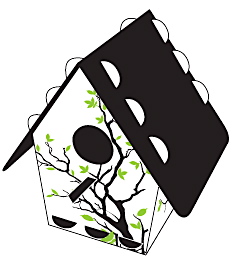-
Entice Birds With Nesting Materials
Most folks start with birdhouses and bird feeders to attract wild birds, and this is the perfect way to explore the great hobby of backyard birding. There are many other ways to increase the number of visitors and the number of species to your yard. Water is the number one element. Many birds who never visit a feeder will frequent a yard that offers a continuous fresh water source like a bird bath. Especially during frigid winters when water sources tend to freeze and become scarce, birds depend on a known spot for fresh water. Our bluebirds even over-wintered here in North Georgia, largely because of the three heated bird baths in the yard. Oh yes, the live mealworms helped too!
Many desired songbirds birds (like cardinals and finches) are not cavity-dwellers either, meaning they’ll never use a birdhouse.
Which brings us to yet another feathered friend favorite. Nesting materials are extremely important to birds in early spring. With a severe shortage in natural habitats, many depend on bird-friendly yards for their residence. There are all kinds of kits which offer refills too. This nesting material wreath is one, complete with feathers, cotton fibers, hemp, and raffia. The Bird Nester is a large, cage-like holder for cotton fiber nesting material, and offers refills as well. Even the Hummer Helper, which is nesting material designed specifically for hummingbirds offers refills.
Offering wild birds nesting materials in your yard really helps them to thrive and flourish. You can even craft your own materials using dryer lint, pet hair, cotton yarns, and mosses used in decorative floral design. Use a standard suet cage for holding the materials, or a mesh produce bag from the grocery store (like the kind apples come in). Late winter to very early spring is the best time to set them outside for birds. Simply hang from a tree branch, where they’ll be easily spotted, or even from one of the arms on your shepherd’s hook……happy birding!
-
Some Really Groovy Birdhouse Kits
Cavity dwelling birds face a very sad real estate problem…good homes are not so easy to come by these days. Mostly because of the vast destruction of natural habitat giving way to strip malls, schools, and more subdivisions. But also from the competition of non-native species. Just who brought over those House Sparrows anyway?
An educational and fun way to provide real nest sites for your feathered friends is with birdhouse kits. The standard wooden kits are widely availabl
e, even as bird feeders and bat house kits. Mostly crafted of durable cedar, they’ll provide many seasons of use and enjoyment. Lately, recycled plastics are the new craze in wild bird accessories, and they’re awesome as far as durability. Most are guaranteed to never crack, split or fade, plus they help to keep these plastics out of landfills. No worries of squirrels gnawing on them like traditional wooden bird accessories.
These recycled birdhouse kits have a unique design that’s fun to assemble, for little kids and big kids too. The groovy designs and vibrant colors are just plain fun, and best of all they provide great nesting sites, as well as roosting spots for wild birds. Th
e 1.25″ entrance is perfect for many small to medium-sized birds, and the perch is removable. These recycled plastic birdhouse kits add a splash of color in the yard, and will look great for years too.
-
Farm Sanctuary V-Logs
WATKINS GLEN, N.Y. – August 13, 2010 – “C’mon,” exclaims Susie Coston,
national shelter director for Farm Sanctuary, the nation’s leading farm
animal protection organization, with a swooping arm gesture reminiscent
of a child rallying her friends to follow her on an exciting adventure.
Six male Holstein calves, dairy farm castaways found just months earlier
on a Pennsylvania farm where they had been left to die without food or
water, one by one rise up on their now strong legs to follow their
charismatic leader out of the barn. Truth is, Coston is simply coaxing
them to rotate pastures, a necessary practice at the sanctuary, but
because of the love and affection she radiates for these calves, and for
the more than 500 other farm animals rescued from abuse and neglect who
reside at the shelter, her call is irresistible. These sweet boys would
follow her anywhere.The sight of calves once too weak to stand bounding after Coston like
playful puppies is a joy that used to be reserved only for those lucky
enough to actually visit one of the organization’s bucolic bicoastal
shelters located in upstate New York and northern California, but now,
thanks to the launch of a new video series entitled Reel Life at Farm
Sanctuary, such exclusive sneak peeks at life behind Farm Sanctuary’s
barn doors will be available for anyone with a computer to see on a
monthly basis.These fascinating v-logs, part of the nonprofit’s popular “Sanctuary
Tails” blog, will transport viewers straight to the beautiful, bustling
sanctuaries where they will follow the activities of shelter staff and
animal residents as they carry out their daily routines. In the first
exciting episode, Coston explains the importance of pasture rotation and
takes viewers right along as she shows the New York Shelter cattle,
sheep and goats that the grass really is greener in different parts of
the farm.“We decided to do a video series because there is such abundance here at
Farm Sanctuary it would be greedy to keep all these sweet, funny,
joyful, and poignant moments that we witness on a daily basis all to our
ourselves,” enthused Coston. “By giving viewers an up-close look at the
wide range of emotions and strong friendships experienced by farm
animals, these v-logs will help inspire new ways of viewing and treating
these incredibly complex and intelligent beings, and hopefully move more
people towards treating them with compassion.”You can view the first installment of Reel Life at Farm Sanctuary here
For more videos in this series, as well as
animal photos of the week and countless other inspiring stories from
shelter directors Susie Coston and Leanne Cronquist, keep checking Farm
Sanctuary’s “Sanctuary Tails”If you would like to speak with Farm Sanctuary National Shelter Director
Susie Coston, please contact Meredith Turner at 646-369-6212 or
[email protected] .About Farm Sanctuary
Farm Sanctuary is the nation’s leading farm animal protection
organization. Since incorporating in 1986, Farm Sanctuary has worked to
expose and stop cruel practices of the “food animal” industry through
research and investigations, legal and institutional reforms, public
awareness projects, youth education, and direct rescue and refuge
efforts. Farm Sanctuary shelters in Watkins Glen, N.Y., and Orland,
Calif., provide lifelong care for hundreds of rescued animals, who have
become ambassadors for farm animals everywhere by educating visitors
about the realities of factory farming. Additional information can be
found at farmsanctuary.org or by calling 607-583-2225.





